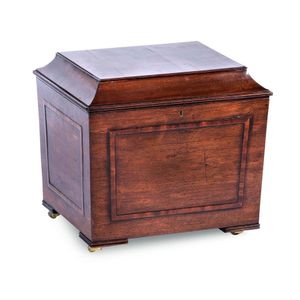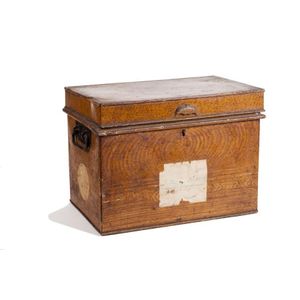Rosemary's Victorian Oak Grained Tin Document Box
A Victorian oak grained tin document box, circa 1880, 27 x 36 x 22 cm. Belonging to Rosemary Anne Stilwell
You must be a subscriber, and be logged in to view price and dealer details.
Subscribe Now to view actual auction price for this item
When you subscribe, you have the option of setting the currency in which to display prices to $Au, $US, $NZ or Stg.
This item has been sold, and the description, image and price are for reference purposes only.
- Oak - Native to Europe and England, oak has been used for joinery, furniture and building since the beginning of the medieval civilisation. It is a pale yellow in colour when freshly cut and darkens with age to a mid brown colour.
Oak as a furniture timber was superceded by walnut in the 17th century, and in the 18th century by mahogany,
Semi-fossilised bog oak is black in colour, and is found in peat bogs where the trees have fallen and been preserved from decay by the bog. It is used for jewellery and small carved trinkets.
Pollard oak is taken from an oak that has been regularly pollarded, that is the upper branches have been removed at the top of the trunk, result that new branches would appear, and over time the top would become ball-like. . When harvested and sawn, the timber displays a continuous surface of knotty circles. The timber was scarce and expensive and was used in more expensive pieces of furniture in the Regency and Victorian periods. - Victorian Period - The Victorian period of furniture and decorative arts design covers the reign of Queen Victoria from 1837 to 1901. There was not one dominant style of furniture in the Victorian period. Designers used and modified many historical styles such as Gothic, Tudor, Elizabethan, English Rococo, Neoclassical and others, although use of some styles, such as English Rococo and Gothic tended to dominate the furniture manufacture of the period.
The Victorian period was preceded by the Regency and William IV periods, and followed by the Edwardian period, named for Edward VII (1841 ? 1910) who was King of the United Kingdom and the British Dominions and Emperor of India for the brief period from 1901 until his death in 1910. - Circa - A Latin term meaning 'about', often used in the antique trade to give an approximate date for the piece, usually considered to be five years on either side of the circa year. Thus, circa 1900 means the piece was made about 1900, probably between 1895 and 1905. The expression is sometimes abbreviated to c.1900.
This item has been included into following indexes:
- boxes, function
- boxes, material or decoration - boxes, oak 86
Visually similar items

A mid-19th century German flame mahogany bureau with cylinder shaped front with a writing surface.
Sold by
in
for
You can display prices in $Au, $US, $NZ or Stg.

A late 19th century walnut bedside cupboard with a frieze drawer above a panel door. 80 cm high, 43 cm wide, 33 cm deep
Sold by
in
for
You can display prices in $Au, $US, $NZ or Stg.

A Georgian mahogany cellarette, English, 19th century, 44 cm high, 49 cm wide, 40 cm deep
Sold by
in
for
You can display prices in $Au, $US, $NZ or Stg.

Antique brass bound writing slope, approx 15 cm high, 29.5 cm wide, 22 cm deep
Sold by
in
for
You can display prices in $Au, $US, $NZ or Stg.
